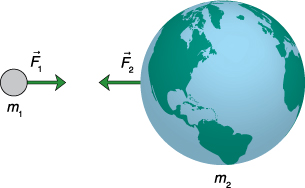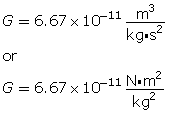Module 4—Gravitational Force
 Explore
Explore
The space station isn’t falling—at least, it isn't falling in the traditional way you think of things falling such as an apple from a tree. Yet the space station and the apple are both accelerating in the same gravitational field produced by the same mass, Earth. Recall Newton’s second law, which will help you understand the universal nature of the force of gravity.
Newton's Second Law
Newton's law of universal gravitation: a law that states the gravitational force of attraction between any two masses is proportional to the product of the two masses and inversely proportional to the square of the distance between them
It is summarized mathematically as
![]()
The sum of all forces, ![]() , acting on a particle is equal to the product of the particle's mass (m) and the particle's acceleration (
, acting on a particle is equal to the product of the particle's mass (m) and the particle's acceleration (![]() ), as illustrated in the following equation.
), as illustrated in the following equation.

How does this equation apply to Newton’s law of universal gravitation?
Newton’s Law of Universal Gravitation

Any two particles exert attractive gravitational forces on each other. The illustration shows two masses, m1 and m2, each consisting of billions of particles, and their attractive gravitational forces, ![]() . Each of these forces is the vector sum of the attractive forces of all the particles in the huge mass on the other mass. Mass1 exerts a force on mass2 that is directed towards mass1 and vice versa. Both forces have the same magnitude
. Each of these forces is the vector sum of the attractive forces of all the particles in the huge mass on the other mass. Mass1 exerts a force on mass2 that is directed towards mass1 and vice versa. Both forces have the same magnitude ![]() .
.
The equation ![]() describes the magnitude of the attractive gravitational force, where r is the separation between the two masses and G is the universal gravitational constant. The value of the universal gravitational constant is
describes the magnitude of the attractive gravitational force, where r is the separation between the two masses and G is the universal gravitational constant. The value of the universal gravitational constant is
universal gravitational constant: the value G in the equation ![]() summarizing Newton’s law of universal gravitation
summarizing Newton’s law of universal gravitation

Applying the Law of Universal Gravitation to Determine Weight
Recall that on the surface of Earth, your weight is the product of your mass and the acceleration due to gravity at Earth’s surface. It is also an application of Newton's second law. Your weight is always directed towards the mass that is causing the acceleration—in this case, Earth.
F = ma
W = mg
Away from Earth’s surface, where the acceleration due to gravity is no longer equal to 9.81 m/s2, your weight is best defined by an application of Newton's law of universal gravitation.
![]()